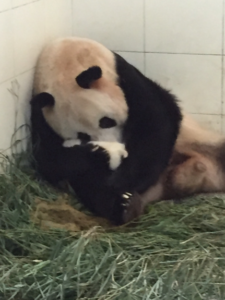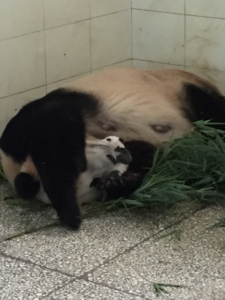Celina Tu updates us on her first few weeks as a PDXWildlife intern-
Well, it’s been a bit more than two weeks here in Ya’an and the apartment is finally starting to feel like home (although the six flights of stairs up to it is not getting easier). We are already making local friends here – they all smile and wave at us as we walk down the street every morning and evening coming to and from the bus stop to work. The best part of coming home is saying hello to this little girl (we call her “Mei Mei, meaning little girl) who lives right downstairs at the apartment complex. She has a smile that brightens up even the rainiest of days here in this small but bustling town. The other two interns – Scout and Sofany – are silliest and funniest and we make a pretty dynamic trio. I think we’re already best friends…

Wen Yu and Celina studying each other
Things up at the panda base are becoming familiar routine as well. To explain things simply, we are collecting raw data (maternal behavior scores, stereotypical behavior scores, and male fecal samples) for three sets of studies. Maternal scores are collected to further understand development of maternal care styles and effects of cross fostering when the mother gives birth to twins. As always with captive animals, we are also collecting stereotypical scores to examine factors affecting stress management and welfare in the Giant Panda. Lastly, we are collecting male fecal specimens in order to create a baseline hormone analysis to compare to levels of hormones during the breeding season.
We have all assigned ourselves bears to observe, here are mine: Maternal care: Mei Xi (twins!) and Cui Cui. Stereotypical: Lin Bing, Ying Hua, Yang Yang, Le Sheng, Cui Cui, Qian Qian, You You, Duo Duo, and Wu Gang.
So far I have only gotten to observe Mei Xi for maternal care and Ying Hua for stereotypical. Mei Xi is such a good mommy! Her little cub (the younger of the two twins) is definitely high maintenance – she barely let’s her mom sleep with all her squawking and squirming!
- Mei Xi and her baby
- Trying to get a little shut eye




How would you describe the stereotypical behavior of your subject pandas? Also I would be interested in knowing how long you watch the pandas and whether the behavior occurs at certain times of the day or all day. Maybe if you could address Ying Hua and Cui Cui’s behaviors? Thanks
As you may know already know, a stereotypical behavior is one that is repetitive and seemingly functionless; the key word here is seemingly – behaviorists have and are collecting data that points to certain theories as to why stereotypical behaviors are performed in captive animals.
Just like for any other species, the stereotypes performed vary per panda. The most performed behaviors that I have seen so far would probably be stereotypic pacing (imagine wearing down a certain path in the grass) and tongue flicking (imagine licking your lips over and over again).
As for when the pandas exhibit these behaviors the most I would say mostly at time when they are going to be fed (morning and late afternoon). I believe – and according to existing studies – that the anticipation of the feeding is a factor that influences the rate of stereotypy (however, the existence of a routine vs. random scheduling is another story in respects to rate and strength of stereotypy).
I hope this answers some of your questions!
-Celina
Sounds exciting! Busy, but exciting! Please keep us posted! We look forwaed to hearing about it!